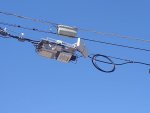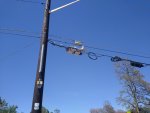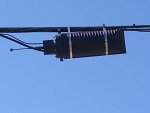You are using an out of date browser. It may not display this or other websites correctly.
You should upgrade or use an alternative browser.
You should upgrade or use an alternative browser.
What's it for?
- Thread starter eyes00only
- Start date
- Status
- Not open for further replies.
doctordialtone
Member
A 5G Cell Site?Any ideas what this is?
nd5y
Member
It looks like it has coax and fiber. Probably cable TV/broadband related.
mmckenna
I ♥ Ø
RRU. Remote Radio Head (looks like there are three of them). It's basically a small cellular base station radio. They are fed remotely over fiber optic cable. In this case, the fiber splice is in the cylindrical enclosure to the RIGHT. Probably pulling power off the cable TV trunk line.
So, small cell site.
No idea if it's 5G or not. Without seeing specifics on the antennas or the RRU's, it would be guessing. With three radio heads, it's probably covering multiple bands.
The tags on the pole might tell you who it belongs to.
So, small cell site.
No idea if it's 5G or not. Without seeing specifics on the antennas or the RRU's, it would be guessing. With three radio heads, it's probably covering multiple bands.
The tags on the pole might tell you who it belongs to.
eyes00only
Member
If I can remember where I saw it I'll check the pole. I was just on a bike ride around the neighborhood.
bb911
Member
Well, it's got a RF caution sticker on it, so I'm going with mmckenna. (An aside: Keep on keeping your eyes on utility poles - I've seen cameras near schools and just recently a small weather station belonging to SCE [SoCal Edison])
eyes00only
Member
eyes00only
Member
Looks like this is owned by Xcel Energy. There are several of the dohickeys & thingamagigs along the same street.
Possibly Remote Meter Reader Tech/Power Condition Monitoring (Power Co related), But looks like a Micro Cell also, likely using same tech/repurposed regardless  or Xfinity Wifi extender type equipment.
or Xfinity Wifi extender type equipment.
Nice Pics !
Nice Pics !
mmckenna
I ♥ Ø
Xcel energy is the local utility. They usually require a kill switch on these things so line crews can safely work around the lines. I doubt they'd be using 3 separate RRU's for meter reading. Often meter reading is done on one frequency. Around here it's 900MHz band.
I suspect since the utility requires it, they label it so their linemen know what it is.
And it's just a fancy coax switch. It disconnects the cable TV power feed from the system.
Fiber optic cable service loop. Since splicing fiber optic cable requires pulling some slack on the cable so it can be stripped back, prepped and fed into a fusion splicer (often inside a trailer), they leave slack in the cable near the splices. Since fiber optic cable has a large bend radius to keep from fracturing the glass, they have to make wide turns with it. It's just a big plastic form to support the cable and maintain the bend radius.
Fiber optic splice enclosure. Fiber comes in (larger of the two cables), the individual strands are fanned out and fusion spliced onto the strands in the smaller cable. The splices are protected in trays that sit inside the splice case. Fusion splicing uses a small electric arc to melt the two ends of the glass together.
CARNIVORE remote site. 
CARNIVORE remote site.
Close! It scans for the chips Bill Gates and the W.H.O. are going to embed into our bodies!
- Status
- Not open for further replies.
Similar threads
- Replies
- 1
- Views
- 389
SDS100/SDS200:
Will no longer hold on System or Dept
- Replies
- 7
- Views
- 388
BCD436HP/BCD536HP:
Can only hear one end on DMR
- Replies
- 2
- Views
- 379






